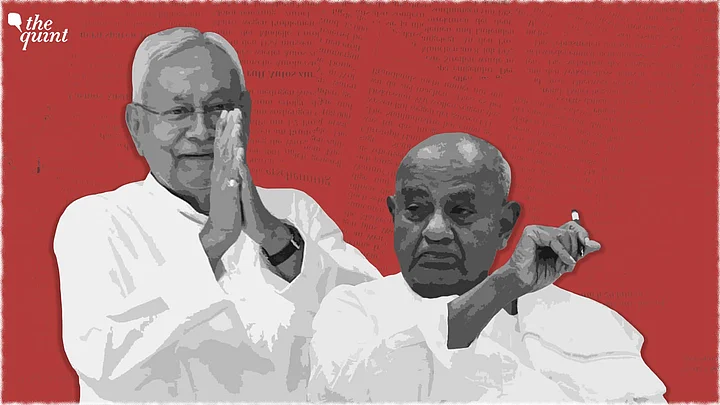The HD Deve Gowda-led Janata Dal (Secular) joined the Bharatiya Janata Party (BJP)-led National Democratic Alliance (NDA) on Friday, 22 September. Ironically, this happened a day after a BJP MP, Ramesh Bidhuri, hurled communal and abusive slurs at one of Deve Gowda's closest confidantes – BSP MP Kunwar Danish Ali.
(You can read more on Bidhuri's slurs here).
Though the JD-S' entry into the NDA can mainly be connected to political developments in Karnataka, it's important due to historical reasons as well.
Why is this Important? Here's a Flashback
Once upon a time in Indian politics, there was an important party called the Janata Dal, without any prefix or brackets. It gave India three Prime Ministers – VP Singh, HD Deve Gowda, and Inder Kumar Gujral and several chief ministers.
For a while in the late 1980s and early 1990s, the party was the main challenger to the Congress and remained an important national party till it began splintering into smaller regional outfits.
The Janata Dal finally ceased to exist when its core leadership split vertically into two factions on one critical issue in 1999 – to join or not join the BJP-led NDA, which was then in power at the Centre.
On one side was the faction led by former prime minister HD Deve Gowda, that was firmly opposed to joining the NDA, and on the other hand, there was the faction led by Sharad Yadav, that was in favour of joining the BJP-led alliance.
Both factions staked claim to the Janata Dal name and symbol and the battle reached the Election Commission (EC). With neither party being able to decisively prove their claim, the EC froze the Janata Dal name and symbol – and the party came to an end.
Two new parties were formed as a result. On one side was HD Deve Gowda's Janata Dal (Secular), that opposed the BJP and made common cause with the larger anti-BJP coalition nationally, though it didn't join any alliance.
On the other hand was the Janata Dal (United) led by Sharad Yadav which joined the NDA. Yadav even went on to become the NDA's convenor later.
The JD-U was further strengthened after George Fernandes and Nitish Kumar's Samata Party, Ramakrishna Hegde's Lok Shakti, and JH Patel's faction within the erstwhile Janata Dal in Karnataka merged into it. After the JD-U came to power in alliance with the BJP in Bihar in 2005, the party gradually became centered around Chief Minister Nitish Kumar.
Deve Gowda's JD-S, on the other hand, formed a post-poll coalition government with the BJP in Karnataka in 2006 but the two parties never formed a pre-poll alliance. Until now.
Ironically, now the JD-S and JD-U have switched sides on the very issue that they had split on – alliance with the BJP.
Why Did The JD-S and JD-U Switch Sides?
This complete U-turn from both the parties – the JD-U going from a BJP ally to now an opponent and JD-S doing the opposite –- is largely to do with the political trajectories of Nitish Kumar and the Deve Gowda family.
In a sense, both leaders faced the same dilemma. Both have been leaders with a national outlook and importance but with a regional base. Both leaders' choices were determined by the need to survive in a national polity that had increasingly come to centre around two national parties 1999 onwards – the BJP and the Congress.
For Nitish Kumar's multiple U-turns, read this piece on why he has switched sides so many times over the last one decade and how he managed to retain power while doing so.
Let's Now Focus on the JD-S
In some ways, the BJP is a natural ally for the JD-S, but in other ways it isn't.
It's a natural ally because in the JD-S' main area of influence – Karnataka's Old Mysore region – its main competition is with the Congress and the BJP is relatively weaker.
By coming together, the two parties can easily consolidate the anti-Congress vote in Karnataka in the Lok Sabha elections next year.
The seat-sharing arrangement could be to the advantage of the BJP – at most, the party would spare five out of Karnataka's 28 seats for the JD-S.
But they aren't natural allies in another aspect.
Muslims have historically been a strong base for the JD-S. It is the JD-S that had given Muslims a small part of the reservation pie in Karnataka, a quota that was scrapped by the last BJP government in the state.
However, this changed in the 2023 Assembly elections in Karnataka. Fearing that the JD-S may go towards the BJP or that its MLAs may shift to the latter, a sizeable chunk of the JD-S' Muslim voters shifted to the Congress.
This led to decisive wins for the Congress in seats where Muslims are in sizeable numbers. The desertion of Muslims significantly weakened the JD-S but it also opened up the possibility of the JD-S and BJP coming closer.
Not surprisingly, the JD-S decision to join hands with the BJP has led a number of Muslim leaders to quit the party, like Syed Shafiullah and NM Nabi.
There is another important factor here. HD Deve Gowda and HD Kumaraswamy both see Karnataka CM Siddaramaiah as their main rival in state politics. To an extent, antipathy to Siddaramaiah is another factor uniting the BJP and JD-S.
Though Deputy CM DK Shivakumar has a better equation with Deve Gowda and Kumaraswamy, he is also a competitor, being from the same Vokkaliga caste. The JD-S fears that after HD Deve Gowda, the Vokkaliga base could shift to Shivakumar.
This is also a preemptive strike from the BJP's side. The party fears that if Congress president Mallikarjun Kharge becomes the INDIA bloc's PM candidate, it could possibly lead to a consolidation in Karnataka. BJP is trying to prevent this by bringing on board the JD-S.
In many ways, threat of the Kharge-Siddaramaiah-Shivakumar troika brings the two parties together.
